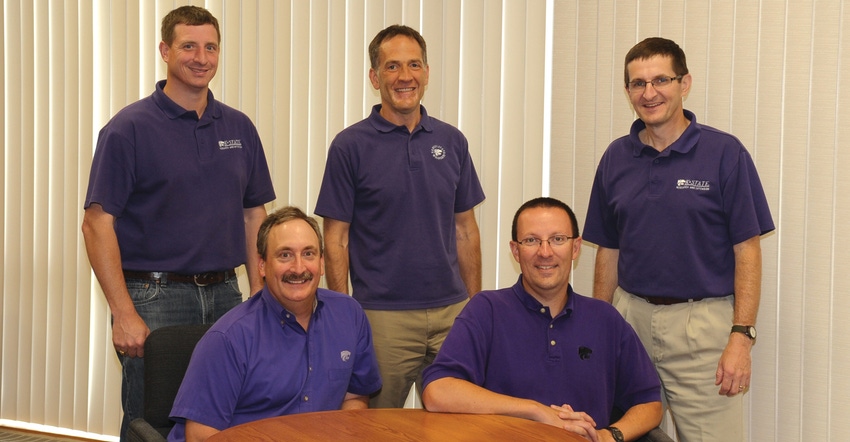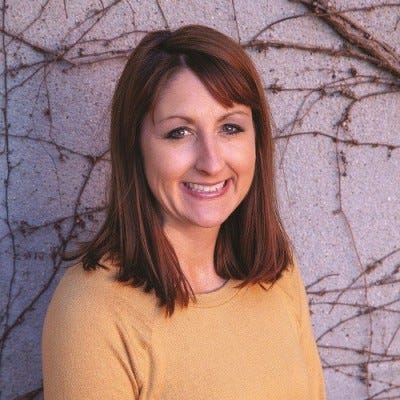'20 Pork Masters: For Goodband's students, door always open
Training future industry leaders is K-State professor's greatest achievement, strongest passion.

Kim Friesen and his project on soybean meal levels and starter diets, Rodger Main and his work on weaning age, Jon De Jong and his feed efficiency calculator, Josh Flohr and his research on space requirements, Kyle Coble and his studies on added copper — these Kansas State University graduate students and their research projects are just a handful Bob Goodband has helped mentor in his 30-plus years of teaching swine nutrition and management. Ask him about his greatest achievements and highlights over the years, and Goodband is quick to rattle off more names.
"As they go through their program and graduate, they've done things that have really moved the program forward, that have made the K-State swine program a better place. And it's that transition, that process, that they go through," Goodband says. "I can think of a couple kids that started that were awfully green, and were certainly enthusiastic and passionate, curious. But just how they've developed their skills and where they are today, it's very rewarding to see the kids, the jobs that they have — really influential people in the swine industry."
With his door-always-open attitude, Goodband has mentored more than 130 graduate students at K-State. He has helped his own students, as well as hundreds more in the Department of Animal Sciences and Industry, perfect their scientific writing skills. He has also served as an outside committee member for students at several other universities. Numerous students have relayed stories of how they would not have been able to complete their degrees without Goodband's patience and guidance.
The list of students that Goodband has mentored through master's degrees and doctorates have been widely recruited by industry and academia. They include professors at Big Ten universities, research leaders in private industry, nutrition company presidents and CEOs, and recent graduates that are just starting their careers.
In a nomination letter for the Commerce Bank Distinguished Graduate Faculty Award, his colleagues wrote, "Dr. Goodband is never the person looking to be the focus of the front-page story and does not strive to be on the cover of the magazines. He does not focus his efforts that bring him the most personal notoriety. Rather, Bob is the one that passionately and quietly does the work that will impact the students and industry he serves."
Goodband says it's a team effort.
"I think we generally have a pretty close relationship with the students. I'd like to think so," he says. "I think we're dedicated to the students' success, and I'd like to think that we offer opportunities for them to excel or succeed in whatever interest area they have, whether it's moving into academia, working for a production system or allied industry."
It's that sense of duty and dedication to training future industry leaders that has placed Goodband in the 2020 Masters of the Pork Industry class.
Penn State piques pig interest
Growing up in Walpole, Mass., Goodband was first exposed to animal agriculture through his father, Gordon. A veterinarian and co-owner of Bruce Animal Hospital in Dedham, Mass., with his brother, his father practiced mixed animal medicine for 30 years.
"I knew from my experiences with my dad that I wanted to be involved in animal agriculture, and so growing up there was a small farm that was close to us and had pigs. And I worked there summers and weekends, and that was my exposure to pigs," Goodband says.
After graduating from high school in 1980, Goodband headed off to Pennsylvania State University to pursue a bachelor's degree in animal production. His adviser, Grant Sherritt, was the head of the swine program and soon became Goodband's mentor.
"He was the pig person, and basically he taught swine science and swine nutrition classes, and he was a big influence," Goodband says. In fact, it was Sherritt who nudged him to head west to continue his education in swine management and nutrition.
"He would take us to places as a group that were looking for employees, kind of as an exposure to jobs in production and management," Goodband says. "After talking to him, he said, 'You know, Bob, your grades are OK. Maybe you should go to graduate school. I know this guy out in Kansas' — who was Bob Hines — 'and you can do very production-oriented research.' And I ended up coming out here."
Goodband's plan was to get his master's and return to Pennsylvania. But after taking classes, working as a teaching assistant and doing practical applied research, Goodband says "things clicked," and he decided to stay on at K-State for a doctorate.
K-State was not the only thing that clicked for Goodband. At first, he planned to study production management, but after conducting some swine nutritional research projects, Goodband soon realized his interest in swine nutrition was growing.
"They were just beginning to look at phase feeding for nursery pigs," Goodband says. "People were moving from 28- to 21-day-old weaning and a complexity of starter diets. And all that was kind of on the forefront, and I was fortunate enough to be able to be involved in research along those lines."
Goodband received his master's in swine nutrition in 1986 and went on to get his doctorate in the same field in 1989. As for teaching, Goodband says like most things in his life, he just kind of "fell into it."
"When I was probably nine months out from graduating, the economy was pretty bad, and the university had a hiring freeze on. And just at the time I was graduating, they lifted the freeze, and we happened to have two swine positions open," he says. "I interviewed for one of them and was able to land it, and that was an Extension teaching appointment."
Yours, mine and ours
Since becoming a K-State assistant professor in 1989 to his current position as professor and Extension specialist in swine nutrition and management, Goodband says he has approached teaching as a team effort and credits team members Mike Tokach, Steve Dritz, Joel DeRouchey and Jason Woodworth in making that a success.
"I always tell people it's a yours-mine-ours approach in that they may work closely with one faculty person on data analysis; they may work closely with a different faculty person on the statistical analysis," Goodband says. "If you take a research project and you break it down into its individual components, everybody kind of lends a hand, and I may help you on this aspect, and Mike may help you on another one and so on. I'm really blessed to be able to work on a team of really smart and dedicated people."
Besides the undergraduate courses that Goodband leads, he teaches swine nutrition and co‐teaches proteins and amino acids on the graduate level — two courses his colleagues say are very important for students. After seeing the need for an additional advanced course for doctoral students pursuing degrees in animal sciences and industry as well as grain science and industry, Goodband organized and led an advanced nutrition course.
Throughout all of his courses, Goodband strives to offer his students a broad experience and in-field training. For example, one of his doctoral students, Lori Thomas, recently conducted an on‐farm sow gestation trial in Nebraska that involved almost 1,000 sows. They weighed over 14,000 piglets at birth. Besides obtaining funding, persuading the farm to conduct the research and helping the student organize the project, Goodband joined the student on weekends to weigh pigs.
He says teaching has its moments, but it's a career he wouldn't trade for any other.
"You know you can have some of the best days when you're involved in teaching. We have a lab out at the hog farm, and kids heat-check or breed sows for the very first time. Kids that don't have any pig experience; they really get turned on, and it's a great experience," Goodband says. "But then the next day you have a quiz over the same thing, and they don't do very well, and you think, 'What did I do?' "

More students to inspire
Further research
Test scores aside, Goodband says he is proud of the students that have gone through the program — not only the undergrads, but also the graduate students. Even after students go on to pursue careers in the industry, Goodband says they often leave the department with ideas for further research.
"The big breakthroughs really come from the graduate students. They do a project, and it turns out this way or doesn't turn out that way, and you go, 'Hmm, this is worthy of pursuing,' " Goodband says.
One recent example of this is the 2019 Ph.D. work Henrique Cemin completed in amino acid nutrition for nursery and grow-finish pigs. While Cemin is now employed with Hubbard Feeds as a swine nutritionist, the K-State team has continued with validation studies and deemed the area worthy of more research.
"It's the curiosity and hard work that the graduate students do and their ideas that turn out to be the big, big factors," Goodband says.
Impacting producers worldwide
Goodband also credits the students for bringing economics into their research. Spending 40% of his time on teaching and an additional 20% on research, Goodband allocates the rest to Extension. He says the questions from producers are always, "What is this going to cost me?" and "What is the return on investment?" Thanks to the quality research his students have conducted over the years, he is easily able to answer those questions.
To quickly get research into producer hands, Goodband publishes almost every experiment in the Kansas Swine Research Report. As editor, he has published 838 research articles, and over the last two years, his articles have been downloaded more than 12,000 times by people in 124 countries.
While Goodband may prefer to talk about his students' success, his scholastic achievements have made a mark in swine nutrition worldwide. His work has resulted in 315 refereed journal papers, six book chapters, more than 977 research reports and Extension publications, eight patents and $10.8 million in research awards.
He has maintained a long-running record of sustained funding from allied industries and the National Pork Board. He has solicited $4.4 million donated for the swine program, scholarships and facility development to the Kansas State University Foundation.
His research has been recognized with seven National Pork Producers Council Innovation Awards and the Outstanding Production Abstract Award at the International Pig Veterinary Science Society meetings.
While his name may be on the papers, patents and publications, Goodband goes back to all the contributors at K-State that have made that possible.
"The whole is greater than the sum of the parts — that by working together, we are really able to accomplish a lot more than one person individually," Goodband says. "I believe in that very strongly; that's been a big success."
Grateful for his K-State team, Goodband is even more thankful for his personal support team. His wife, Danielle, whom he married during his first year of teaching at K-State, and his son, Brady, have been his biggest backers at home.
More students to inspire
Goodband says he's in no hurry to retire and hopes to continue to see the K-State swine program grow.
"In swine science class 25 years ago, we would have had maybe three or four out of 25 kids interested in pigs; now it's eight to 10. I hope we're showing kids the swine industry, and that there really is a lot of technology and sustainability, and decisions — if we do this and it affects farrowing rate, how much is that going to influence pig prices?" Goodband says. "I really think that's an important message we need to get out to kids, and maybe more so the undergrads than grad students, but there's tremendous opportunity out there."
Opportunity aside, Goodband says he is having too much fun to hang up his hat now.
"Of the group, I'm probably the person closest to retirement, but it's still fun," Goodband says. "I have the best job on campus. You know, I get to come in every day and work with my best friends and students, and it really is neat to get to go to work as opposed to have to go to work."
About the Author(s)
You May Also Like





